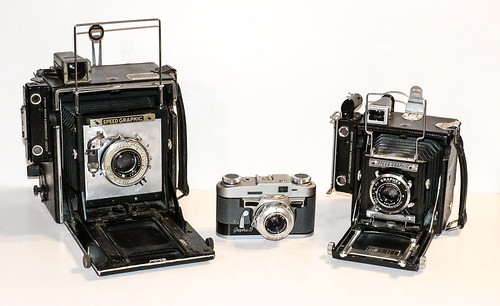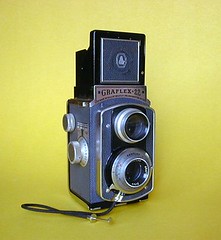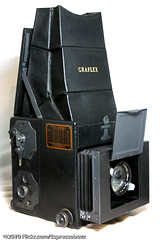Graflex

|
| The "Graphic" Gang image by Neal Wellons (Image rights) |
The name Graflex may mean either:
- The main camera brand used by Folmer & Schwing, and (after 1905) the Folmer & Schwing Division (of Kodak).
- The Folmer Graflex Corporation, the company that succeeded Folmer & Schwing when it had to be sold by Kodak in 1926.
- The Graflex SLR, one of two principle products of both companies.
Contents
Company
| photography related industry in Rochester (New York) |
| American Camera | Bausch & Lomb | Blair | Century | Crown Optical Co. | Elgeet | Folmer & Schwing | Gassner and Marx | Graflex | Gundlach | Ilex | JML | Kodak | Milburn | Monroe | PMC | Ray | Reichenbach, Morey and Will | Rochester Camera and Supply Co. | Rochester Optical Co. | Rochester Panoramic Camera Co. | Seneca | Sunart | Walker | Webster Industries | Wollensak |
| and in Rochester (Minnesota) |
| Conley |
| external links |
| graflex.org - Rudolf Kingslake's "Optical industry in Rochester (N.Y.)" |
Graflex was an American camera manufacturer based in Rochester known for its press cameras, and large format SLRs. Graflex produced a variety of camera products for a wide variety of formats over the company's 80 year history. It had the enviable position of being the industry standard for press photographers for largely six decades. For a little over half a century, Graflex and Graphic cameras captured the newsworthy and memorable pictures of history. Likewise, no other camera builder has as many Pulitzer Prizes associated with its cameras.
Notable Users
Listed below are some notable photographers and the Graflex cameras they shot.
Graflex
- Dorothea Lang (4x5 Series D, 5x7 Graflex)
- H. Armstrong Roberts; stock photo inventor, photographer (4x5 Series D)
- Jack Dixon; Photojournalist (4x5 Series D)
- Joseph Jasgur; Portrait photographer (photographed Marilyn Monroe) (4x5 Super D)
- Lewis Hine; Documentary photographer, social reformer (4x5 Series D, 4x5 Auto Graflex)
- Margarette Bourke-White (see below)
- Martin Johnson; American documentary filmaker, photographer, adventurer (Various formats Graflex, Graphics)
- Tina Modotti; Italian photographer, actress, political activist (3x4 Graflex)

|
| Crown Graphic Special image by Cameron Shaw (Image rights) |
Graphic
- Arthur Fellig Aka Weegee the Famous; NY & LA freelance press photographer (4x5 Speed)
- Ansel Adams; American landscape photographer (3x4 Speed, 4x5 speed, 8x10 Century Universal)
- Barbara Morgan (4x5 Speed)
- Bill Gallagher (4x5 Speed)
- David Burnett (4x5 Speed)
- Edward Weston; American landscape photographer (8x10 Century Universal)
- Joe Rosenthal (4x5 Speed)
- Louis Mendes; NY street and portrait photographer (4x5 Speed)
- Margaret Bourke-White; American Documentary and Press photographer (Series D, Graflex Singside camera, Speed graphic, Crown Graphic, K20 Aerial camera)
- Nat Fein; Photojournalist (4x5 Speed)
- Yashushi Nagao; Photojournalist (4x5 Speed)
- Berenice Abbott; American Portait, Architecture, Science photographer (8x10 Century Universal)
History
Graflex Inc. began its life as the Folmer & Schwing company, of New York City. William F. Folmer was a serial inventor, and went into business with William E. Schwing. Their company originally produced gas lamps, but expanded into bicycles and photographic equipment, later focusing on cameras exclusively; after introducing their focal plane camera in 1899. [1] With the success of their focal plane cameras, they would be bought out by George Eastman in 1905, and integrated into Kodak as the Folmer Graflex division of Eastman Kodak by 1907. By 1921, Kodak had become a camera manufacturing monopoly in the United States, and was forced to divest itself of several assets, including Folmer Graflex. [2] Failing to find a buyer, the company was spun off as Folmer Graflex Corporation in 1928. In the late 1920's and early 30's Graflex would simplify its product lineup, and redesign its press cameras to take advantage of new technology like flashbulbs. It would introduce the National Graflex in 1933, it's first attempt at a mass market camera. In 1940, Graflex introduced its anniversary Graphics, refreshing the styling and mechanics to better take advantage of flash equipment and synchronized shutters. In 1945 it was renamed to Graflex Inc. . In 1948 it introduced the Graflex Super D, the first Graflex SLR with flash synchronization from the factory. From the depression of the 1930s to 1957 the company grew from 100 to 760 employees, and expanded to having a western branch in Los Angeles California. In the 1950's, Graflex would buy out the tooling and design of the Ciro 35 and Ciro-flex, renaming them the Graphic 35, and Graflex 22 respectively. The company remained independent until 1958, when it was bought by General Precision before being sold to Singer Corp. in 1968. In 1965, the company introduced the Graflex XL, based on the same concept as the Mamiya Press and Linhof Technika Press. By the 1970's, much of the consumer camera products had been discontinued due to Japanese imports, and with the shift towards 35mm and 120 SLR's in the professional market, Graflex's historical professional customer base had largely eroded. In 1976 Cambo purchased the complete tooling, know-how and production of the Graflex XL camera from Singer Educational Systems, and marketed a slightly updated version as the Cambo XL for a time.[3] Rights to the 4x5 Speed Graphic and Crown Graphic were bought by the Japanese manufacturer of Toyo view cameras around the same time.[4]
Cameras from Graflex and its predecessor Folmer & Schwing

|
| Graflex 22 TLR image by Bill Strong (Image rights) |
35mm Film
- Graflex Ciro 35
- Graflex Graphic 35
- Graflex Graphic 35 Jet
- Graflex Century 35
- Graflex Century 35A
- Graflex Century 35NE
- Graflex Stereo Graphic (see also Wray Stereo Graphic)
- Graphic 35 Electric (name variant of the Iloca Electric)
- Graflex Photorecord
Medium Format Rollfilm

|
| Auto Graflex showing typical style of early Graflex SLRs image by EspressoBuzz (Image rights) |
Sheet Film Cameras
- Auto Graflex - 3¼×4¼, 4x5 SLR
- Revolving Back Auto Graflex - Drop bed 3¼×4¼, 4x5 SlR
- Stereo Auto Graflex - 3¼×5½ Stereo Pair SLR
- Auto Graflex Junior - 2¼x3¼ SLR
- Compact Graflex - 3¼×5½ SLR
- Naturalist Graflex - Telephoto 4x5 SLR
- Home Portrait Graflex - 5x7 SLR
- Press Graflex - 5x7 SLR
- Graflex Series B - 2¼x3¼, 3¼×4¼, 4x5, 5x7 SLR
- Graflex Series C - 3¼×4¼ SLR
- Graflex Series D - 3¼×4¼, 4x5 SLR
- Graflex Super D - 3¼×4¼, 4x5 SLR
- Graflex reflex models
- Graflex Fingerprint Camera - 2¼x3¼ Forensic Camera
- Graflex Speed Graphic (Super, Super Speed, Pacemaker Speed, Pacemaker Crown and Century Graphic)
- Crown View

|
| Super Speed Graphic image by rawheadrex (Image rights) |
- Graphic View cameras
- Super Speed Graphic
- Graflex XL
- Century Studio camera
- Century Universal Camera
- Graphic Ringside Camera
Aerial Cameras
The K20, and perhaps others, were designed by Fairchild, and so may also be known as Fairchild K20.
- Folmer Graflex K20 Aircraft Camera
- Folmer Graflex K21 Aircraft Camera
- Folmer Graflex K25 Aircraft Camera
Notes
- ↑ Schilling, Donovan (2015). Made in Rochester. Victor, NY: Pancoast Publishing. p. 76. ISBN 978-0983849667. Retrieved 30 January 2016.
- ↑ United States v. Eastman Kodak Co., 226 F. 62 (W.D.N.Y.1915) appeal dismissed, 255 U.S. 578, 41 S. Ct. 321, 65 L. Ed. 795 (1921)
- ↑ British journal of photography - Volume 123 (1976), p. 575
- ↑ Journal of the Biological Photographic Association, Volume 45 (1977) p. 24
Links
- www.graflex.org resource site, especially for Crown and Speed Graphics
- Documents at Mike Butkus' Orphan Cameras:
- 1943 brochure about the company's main product lines Graflex an Speed Graphic
- PDF manuals
- Catalogs (1920 - 1980s) showing pricing of various Graflex cameras when released.
- Graphic 35mm camera PDF manuals from OrphanCameras.com
- learn more about personalising the Speed Graphic camera with extreme lenses
- Complete Graflex camera listing with detailed info at Historic Camera
- Graflex Cameras Price Guide at CollectiBlend
- Cameras and User manuals at www.collection-appareils.fr (in French)
- Crown Graphic Special video presentation by YouTuber Kay's Cameras